Overview
This article serves as a comprehensive guide for women seeking to eliminate the pouch on their stomachs, detailing various strategies that encompass:
- Understanding the underlying causes
- Effective exercises
- Nutritional approaches
- Both non-surgical and surgical options
It underscores the necessity of professional guidance in this journey. Achieving a flatter stomach demands a multifaceted approach that addresses hormonal factors, lifestyle choices, and personalized support. This is supported by evidence from studies and expert insights throughout the content, illustrating that a well-rounded strategy is crucial for success.
Introduction
In a world increasingly focused on health and wellness, the issue of abdominal fat—often referred to as the "stomach pouch"—has become a significant concern for many. This phenomenon, characterized by the accumulation of fat and loose skin below the belly button, can arise from various factors, including:
- Hormonal changes
- Genetics
- Pregnancy
- Lifestyle choices
Understanding these underlying causes is crucial for individuals seeking to tackle this issue effectively. From exploring non-surgical treatments to adopting healthy lifestyle habits, this comprehensive guide delves into the multifaceted approach required to reduce abdominal fat and enhance overall well-being. With insights from health professionals and practical strategies, readers will gain the knowledge needed to embark on their journey toward a healthier, more confident self.
Understanding the Stomach Pouch: Definition and Causes
The pouch on a woman's stomach, commonly referred to as a 'belly pooch,' signifies the accumulation of fat and, at times, loose skin in the midsection, typically situated below the belly button. This condition can arise from various factors, including hormonal fluctuations, genetic predispositions, pregnancy, and lifestyle choices such as diet and physical activity. Understanding these causes is essential for effectively addressing the issue.
Key contributors to the development of a stomach pouch include:
-
Hormonal Changes: Hormonal fluctuations, particularly during menopause, can significantly influence fat distribution, leading to increased storage in the midsection. Research indicates that hormonal shifts can alter metabolism and fat storage patterns, making this a critical factor in the buildup of belly fat. As Howard E. LeWine, MD, Chief Medical Editor at Harvard Health Publishing, notes, understanding these hormonal changes is vital for addressing belly fat effectively.
-
Pregnancy: During pregnancy, the stomach muscles undergo stretching and weakening, which can lead to a pouch on a woman's stomach after delivery. This change is often compounded by hormonal influences that promote fat retention in the belly area.
-
Genetics: Genetic factors play a crucial role in determining body fat distribution. Individuals with a family history of belly fat accumulation may be more predisposed to developing a stomach pouch.
-
Lifestyle Factors: Sedentary behavior, poor dietary choices, and insufficient physical activity are significant contributors to the development of belly fat. Engaging in regular exercise and maintaining a balanced diet are essential strategies for mitigating this risk. Strategies to reduce abdominal fat include eating a healthy diet, engaging in regular physical activity, getting adequate sleep, and managing stress. A longitudinal study examining lifestyle factors and abdominal fat changes highlighted that increased soluble fiber intake and vigorous physical activity can significantly reduce visceral adipose tissue (VAT) accumulation. This underscores the significance of lifestyle interventions in preventing obesity and associated risks. Furthermore, bariatric surgery might assume a progressively significant role in reducing the risk for heart disease and diabetes among individuals with excessive abdominal fat.
Comprehending these factors not only aids in addressing the aesthetic issues linked to a stomach pouch but also emphasizes the importance of overall well-being and wellness strategies. By focusing on hormonal balance, maintaining a healthy lifestyle, and recognizing genetic predispositions, individuals can take proactive steps toward reducing abdominal fat and enhancing their well-being. Furthermore, organizations can foster a healthier team culture by collaborating with Foresight Health Coaching, which provides customized wellness programs aimed at improving employee well-being, productivity, and cognitive performance.
These programs offer individualized support and exercise strategies that can significantly enhance overall workplace well-being and productivity.
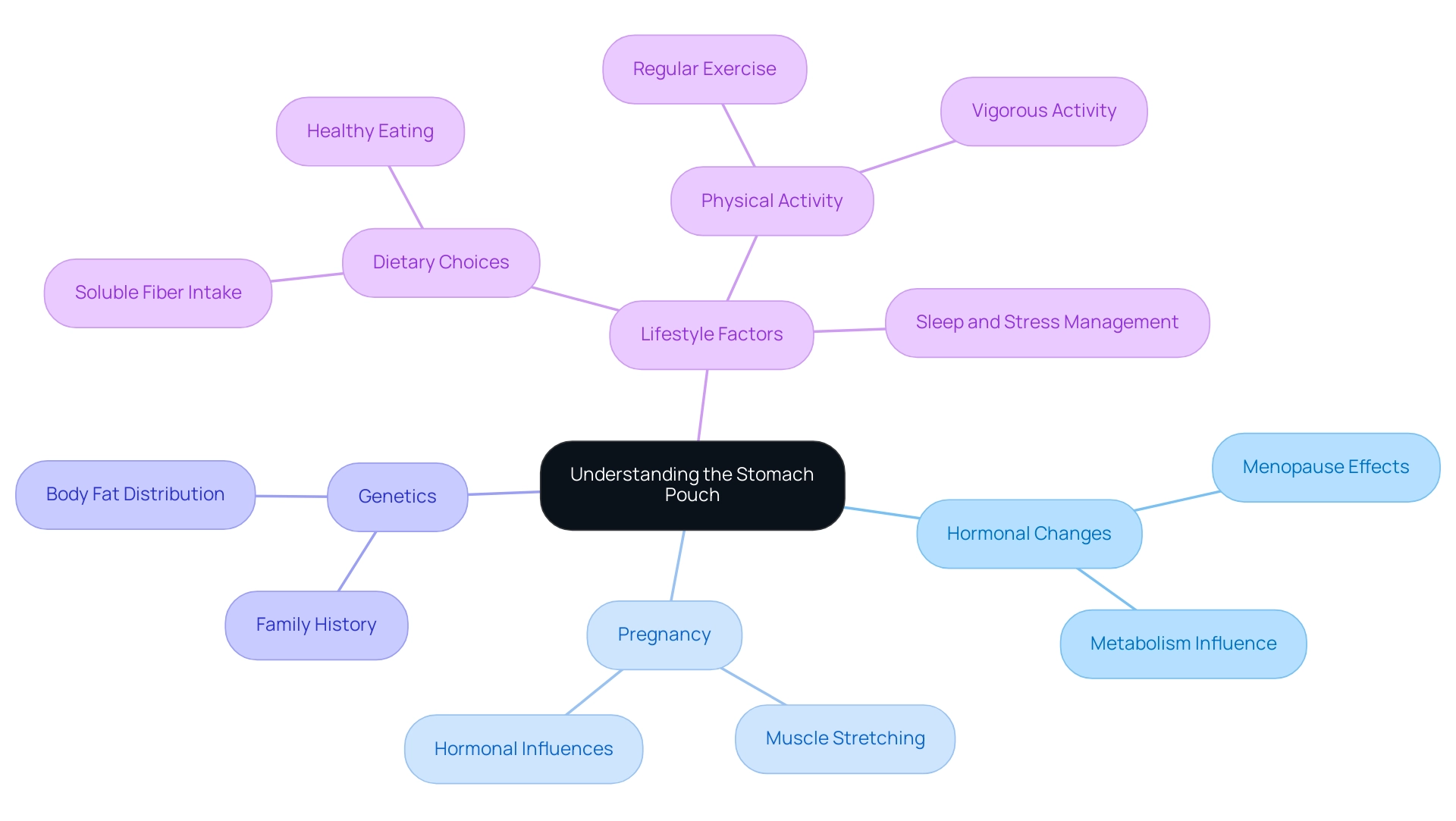
Common Concerns About Abdominal Changes Post-Pregnancy
Following pregnancy, many women face significant changes in their midsection, often resulting in a pouch on the stomach, which intensifies concerns about body image and overall health. Key issues include:
-
Diastasis Recti: This condition arises when the abdominal muscles separate, leading to a noticeable bulging effect. Research indicates that diastasis recti is prevalent among postpartum women, with studies revealing that a substantial percentage experience this separation, often raising concerns about core strength and appearance. A descriptive cross-sectional study titled "Study on Diastasis Recti Abdominis (DRA) in Primiparous Women" highlighted significant concerns among women regarding their abdominal appearance and knowledge about DRA, underscoring the need for better education and support for postpartum women facing body image issues. Personalized coaching can provide the guidance needed to address these concerns effectively.
-
Loose Skin: After childbirth, the skin may struggle to regain its pre-pregnancy elasticity, contributing to the pouch effect. This loose skin can create a pouch on a woman's stomach, significantly impacting her body image, as many feel dissatisfied with their post-pregnancy appearance. Experienced coaches can offer tailored strategies to help women regain confidence in their bodies.
-
Weight Retention: The challenge of shedding the weight gained during pregnancy can be frustrating for many women, often leading to decreased self-esteem and motivation. Statistics show that a considerable number of women find it difficult to return to their pre-pregnancy weight, which can exacerbate feelings of dissatisfaction with their bodies. Customized wellness and fitness coaching can empower women to make enduring lifestyle adjustments that encourage healthier habits.
Incorporating regular physical activity into their routines can be beneficial; studies indicate that employees who engage in such activities for at least 30 minutes three times per week are more likely to report feeling motivated at work. This motivation can translate into improved self-esteem and body image for postpartum women.
Understanding these concerns is crucial for developing effective, personalized strategies to address them. By recognizing the psychological and physical implications of diastasis recti, loose skin, and weight retention, healthcare providers and support systems can better assist women in navigating their post-pregnancy journeys. As Gately Garnett noted, creating an environment that integrates foundational knowledge and progressive creativity is essential for supporting women dealing with body image issues post-pregnancy.
This tailored approach not only fosters a healthier body image but also promotes overall well-being. Furthermore, Corporate Membership - Contact Our Health Coaches Today provides organizations with an opportunity to foster a healthier team culture, which can support women's health and well-being during the postpartum period.
Contact us today to start your journey towards a healthier you!
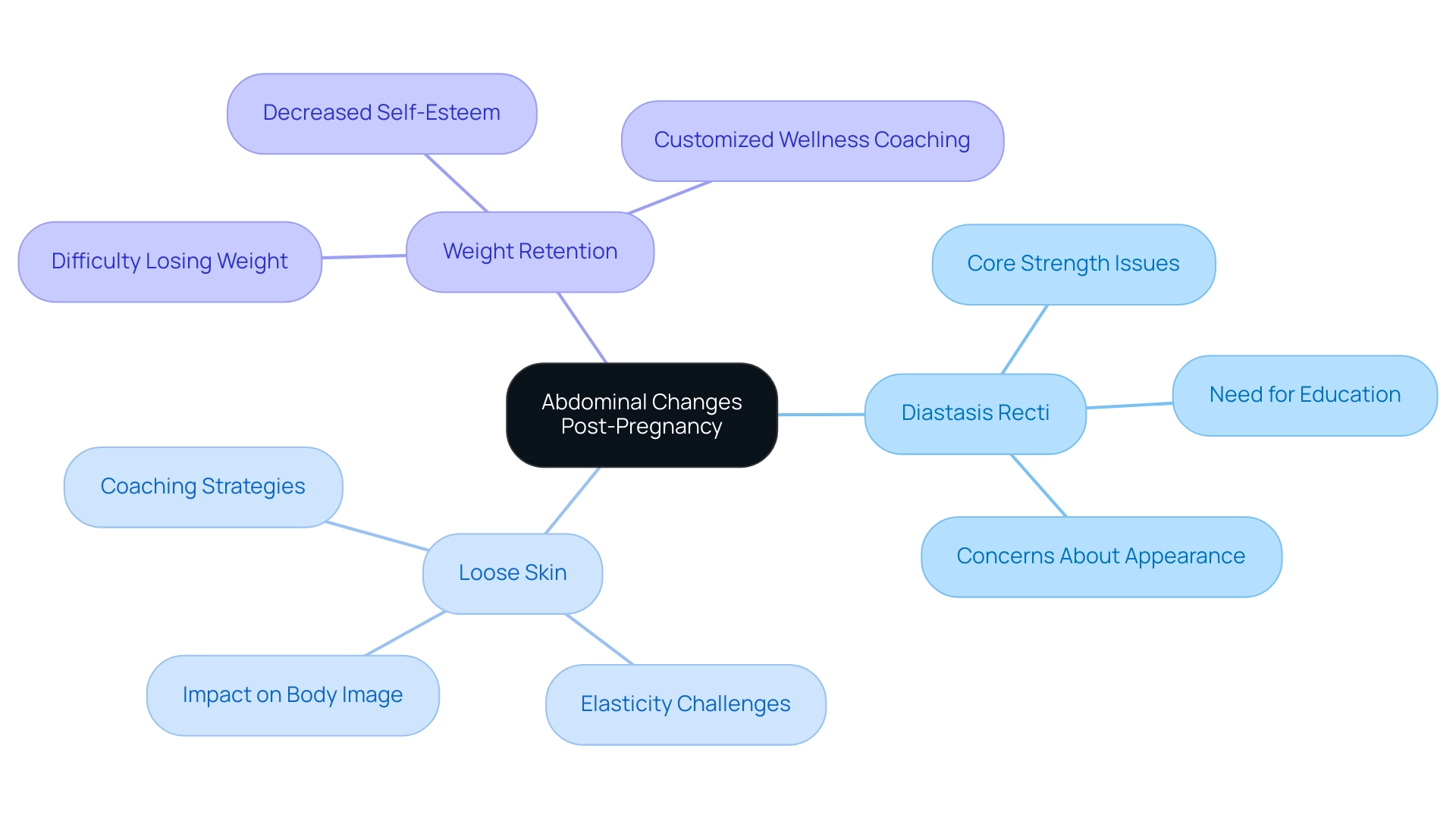
Non-Surgical Treatments to Reduce the Stomach Pouch
Several non-surgical treatments have proven effective in reducing the stomach pouch, each offering unique benefits:
-
CoolSculpting: This innovative, non-invasive procedure utilizes controlled cooling to freeze fat cells, which are subsequently eliminated by the body over time. Many patients report satisfactory results after just one session, making it a popular choice for those seeking discreet body contouring without incisions or scars. The natural appearance of results often resembles the outcomes of diet and exercise, allowing clients to enhance their body shape without drawing attention. Additionally, a case study highlights that clients can undergo treatment without visible signs, achieving their desired body shape naturally over time.
-
SculpSure: This FDA-cleared treatment specifically targets fat in the abdomen and flanks, with sessions lasting about 25 minutes. Results are usually evident in about 6 weeks, making it an efficient choice for those seeking to reduce belly fat.
-
Ultrasound Therapy: This technique employs sound waves to specifically target and reduce fat in the pouch on a woman's stomach. Recent studies indicate that ultrasound therapy can yield significant fat loss, with success rates improving as more sessions are completed. Patients typically require three or more treatments to achieve their desired results, which can be maintained with a healthy lifestyle.
-
Radiofrequency Treatments: These treatments work by applying heat to tighten the skin and reduce fat. The heat stimulates collagen production, leading to firmer skin and a more contoured appearance. This method is particularly effective for individuals looking to enhance skin elasticity while addressing fat deposits.
Consulting with a qualified professional is essential to determine the most suitable option based on individual needs and goals. Each treatment offers distinct advantages, and a tailored approach can maximize effectiveness in achieving a flatter stomach, particularly for those with a pouch on a woman's stomach. As Roy Kim, MD, states, "If you are a model or a movie star or an aspiring one, yes, I would definitely go for it, no questions asked, just do it.
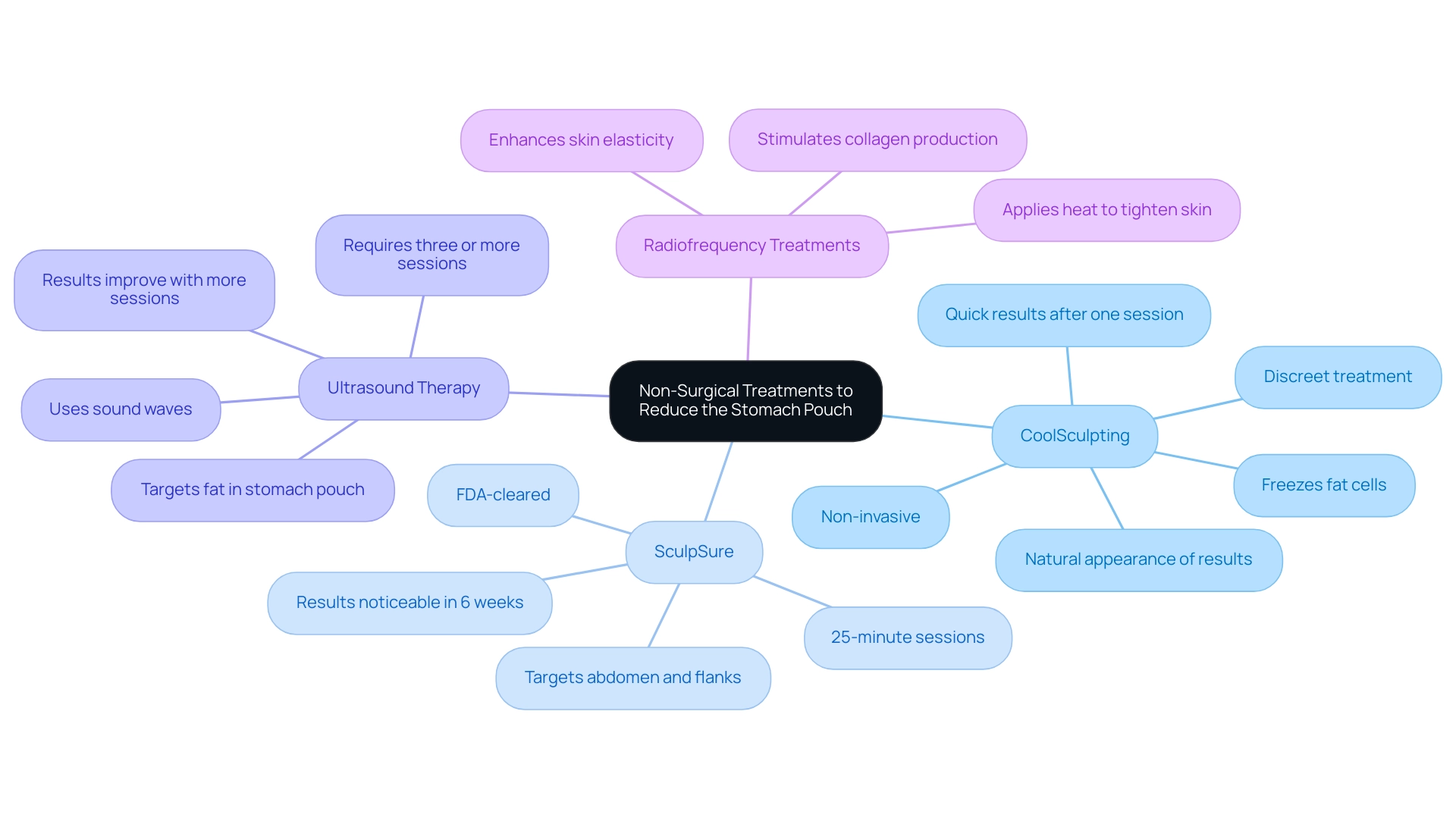
Effective Exercises for Targeting Abdominal Fat
Incorporating specific workouts into your routine can significantly reduce midsection fat and enhance overall team performance. Here are effective strategies, backed by the comprehensive health coaching services offered by Foresight Health Coaching:
- Cardio Workouts: Engaging in activities such as running, cycling, or swimming is essential for burning calories and decreasing overall body fat. Current research indicates that individuals who engage in regular cardio routines can experience a notable reduction in abdominal fat, with studies showing that consistent aerobic activity can lead to a 5-10% decrease in body fat over time. Notably, most qualified publications scored 'very good quality' in their evaluations of effectiveness for fat loss. Foresight's customized fitness coaching can assist individuals in creating a personalized cardio routine that aligns with their lifestyle and objectives.
- Strength Training: Including activities like squats, lunges, and deadlifts not only builds muscle but also boosts metabolism. Strength training has been shown to increase resting metabolic rate, which is crucial for long-term fat loss. In fact, a recent study highlighted that individuals who engage in strength training can boost their metabolism by up to 15% post-exercise, making it a vital component of any fat loss regimen. Foresight's fitness coaches offer tailored strength training plans via their app, ensuring that every participant obtains the guidance required to enhance their workouts.
- Core Activities: Focusing on the abdominal muscles with routines like planks, leg raises, and bicycle crunches assists in toning and reinforcing the area. These activities not only enhance core stability but also aid in better posture and overall functional fitness. Additionally, Carla E. Cox highlights that merely 30% of patients receive guidance regarding physical activity during appointments, underscoring the significance of proactive well-being initiatives in corporate wellness programs. Foresight's wellness workshops can educate employees on the significance of core strength and provide practical tips for integrating these activities into their daily routines.
To achieve optimal results, aim for at least 150 minutes of moderate aerobic activity each week, complemented by strength training routines on two or more days. This balanced approach not only encourages fat loss but also improves overall wellness, ultimately benefiting organizational performance. Furthermore, the case study on 'Age-Related Training Adaptations' underscores the need for tailored exercise recommendations based on age, crucial for addressing the diverse workforce HR managers may encounter.
With Foresight Health Coaching, organizations can implement these strategies effectively, ensuring that all employees have access to the resources they need for lasting lifestyle changes. For more details on our corporate memberships, which include in-person wellness talks, nutrition services, and access to our wellness app, please reach out to us today.
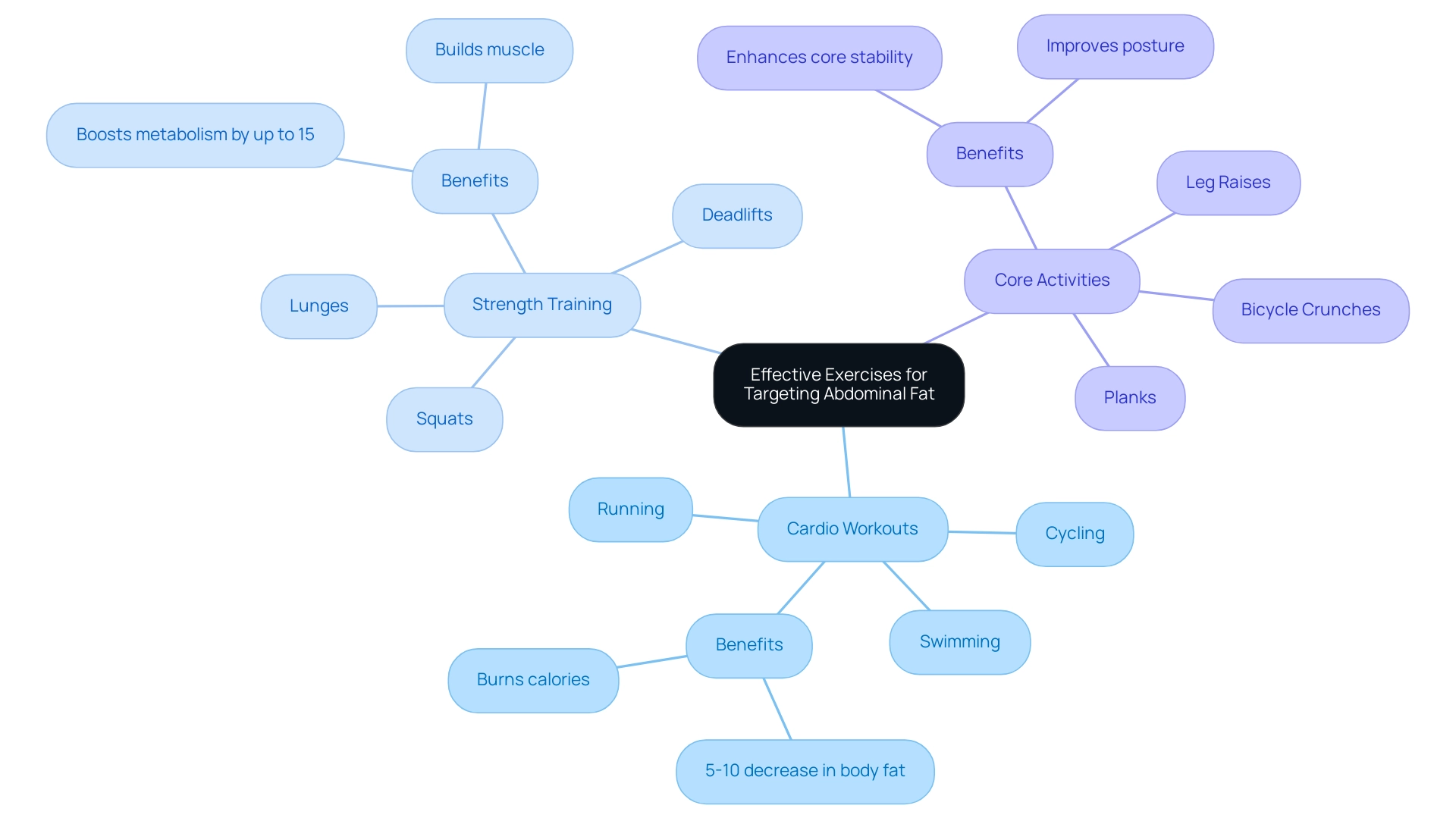
Nutritional Strategies to Support Abdominal Fat Loss
Adopting healthy eating habits is crucial for effectively reducing the pouch on a woman's stomach, and Foresight Health Coaching's corporate wellness programs can play a significant role in supporting these efforts. Here are key strategies to consider:
-
Increase Protein Intake: Incorporating lean proteins into your diet is essential for building muscle and promoting fat loss. High-protein diets have been shown to enhance muscle synthesis and support weight management, making them a vital component of any fat reduction plan. According to a recent case study titled "Protein Needs Assessment," understanding protein needs is crucial for maintaining health, especially for those on restrictive diets or weight-loss medications. Most individuals can achieve their protein intake through balanced meals rather than supplements, emphasizing the importance of whole foods. Foresight Health Coaching can provide tailored nutritional guidance to help employees meet their protein needs effectively, contributing to reduced absenteeism and lower healthcare costs.
-
Limit Sugars and Refined Carbs: Reducing the intake of sugars and refined carbohydrates can significantly impact insulin levels, which in turn helps decrease fat storage. Recent statistics indicate that a reduction in sugar consumption is linked to improved belly fat management, highlighting the importance of mindful eating. Additionally, it is important to consider protein supplements; if using them, look for options with low saturated fat, low sugar, and no trans fats. Foresight's wellness programs can educate employees on making healthier choices that align with these goals, ultimately fostering a healthier workforce.
-
Eat Plenty of Fiber: Foods rich in fiber not only promote feelings of fullness but also aid in reducing overall calorie intake. A diet rich in fiber can result in improved digestion and weight management, making it an effective approach for those aiming to reduce the pouch on a woman's stomach and excess abdominal fat. Foresight Health Coaching can assist in creating meal plans that prioritize fiber-rich foods, enhancing employee well-being and productivity, which can lead to increased engagement and loyalty.
-
Stay Hydrated: Maintaining proper hydration is essential for controlling hunger and enhancing metabolic processes. Drinking adequate amounts of water can help curb cravings and support overall health, contributing to effective weight management. Foresight's programs encourage hydration as part of a holistic approach to wellness, which can further support the overall goals of the corporate wellness initiatives.
Incorporating regular physical activity is also vital; studies show that employees who exercise for at least 30 minutes three times per week are more likely to report feeling motivated at work. This motivation can translate into better adherence to dietary strategies for fat loss. Foresight Health Coaching's partnership offers organizations the opportunity to build a healthier, more cohesive team culture, which can further support these dietary strategies.
For personalized dietary advice tailored to individual needs, consulting a nutritionist can provide valuable insights and strategies to optimize your approach to fat loss.

Surgical Options for Stomach Pouch Removal
For individuals contemplating surgical options to eliminate excess fat and skin, several effective procedures are available:
-
Liposuction: This minimally invasive procedure targets specific areas of the body, including the abdomen, to remove stubborn fat deposits. Recent statistics indicate that liposuction boasts a high satisfaction rate, with over 90% of patients reporting positive outcomes post-procedure.
-
Tummy Tuck (Abdominoplasty): This surgical intervention not only removes excess skin and fat but also tightens the abdominal muscles, providing a firmer appearance. Current data shows that tummy tuck procedures have a success rate of approximately 95%, with many patients experiencing significant improvements in body image and self-esteem.
-
Panniculectomy: Often performed after substantial weight loss, this procedure focuses on removing overhanging skin and fat. It is particularly beneficial for individuals who have experienced drastic changes in body shape, leading to improved comfort and mobility.
Consulting with a board-certified plastic surgeon is crucial to determine the most suitable option based on individual circumstances. Expert opinions emphasize the importance of personalized assessments, as each patient's needs and goals can vary significantly. Dr. Williams notes, "They are continuing to ask the right questions," highlighting the necessity of thorough discussions with qualified professionals.
Furthermore, it is essential to consider the broader context of well-being and wellness. Studies indicate that employees who engage in regular physical activity report higher motivation and reduced absenteeism, contributing to a more cohesive team culture. By engaging in comprehensive discussions with a qualified expert, individuals can make informed choices that align with their wellness and aesthetic objectives, ultimately fostering a happier, more cohesive team culture.
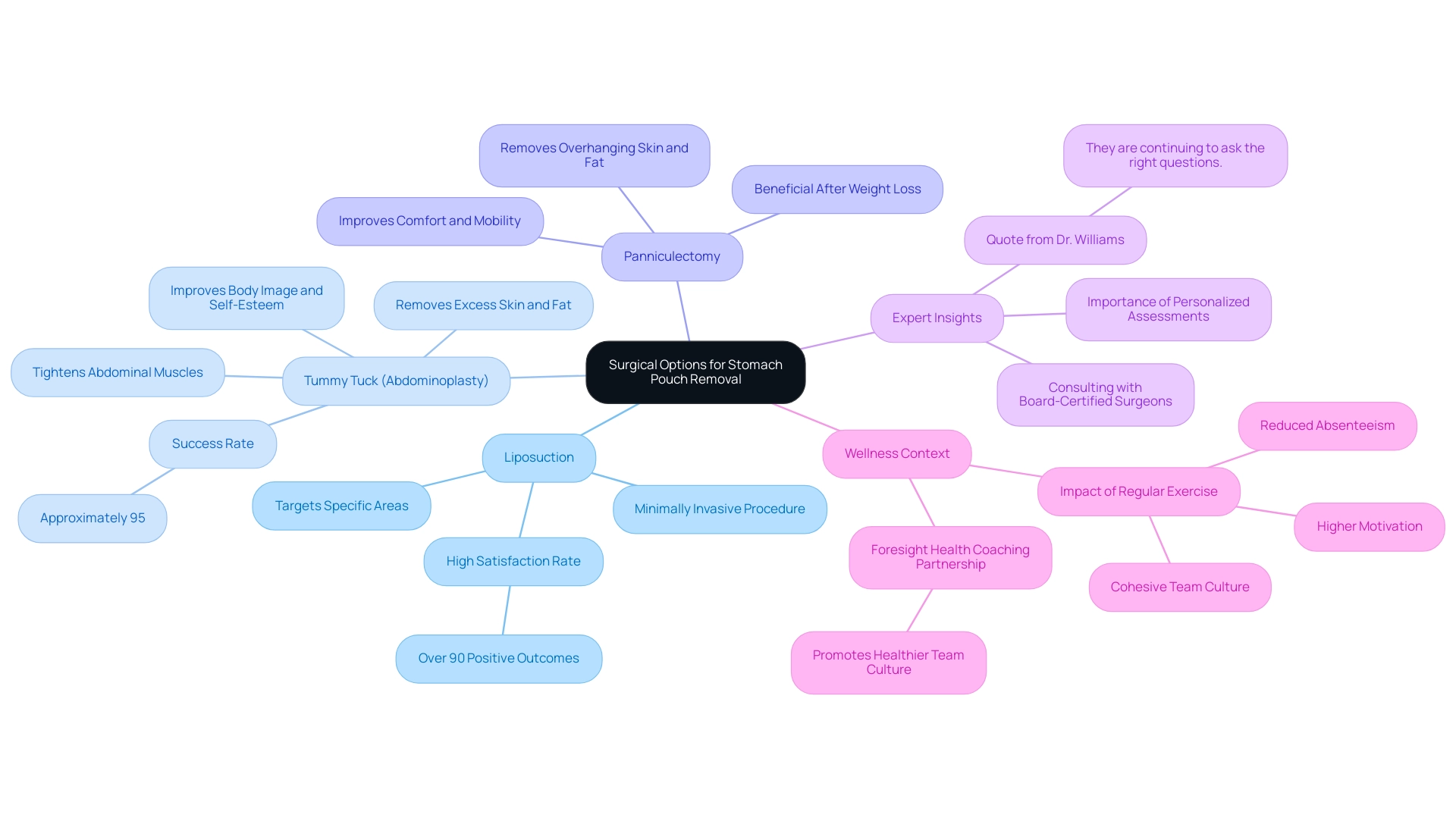
Adopting Healthy Lifestyle Habits for Lasting Change
To achieve lasting change and effectively manage weight, consider incorporating the following healthy lifestyle habits:
- Regular Physical Activity: Aim for a balanced routine that includes both cardiovascular activities and strength training. Participating in physical activity for a minimum of 150 minutes weekly can greatly improve overall well-being and assist in weight management. Research shows that individuals who maintain regular exercise routines experience improved mood, increased motivation, and enhanced cognitive function, all of which contribute to a more productive work environment.
- Balanced Diet: Focus on consuming whole foods, such as a variety of fruits, vegetables, lean proteins, and whole grains. Studies indicate that a balanced diet not only aids in weight management but also plays a crucial role in reducing risks associated with high body mass index (BMI). The World Health Organization emphasizes the significance of accessible and nutritious diets, particularly in urban and underserved communities, as a strategy to combat obesity and enhance public well-being outcomes. This approach is further supported by the WHO's promotion of nutritious diets, viewed as a critical component in reducing obesity rates and improving public health, especially in regions facing significant socio-economic challenges.
- Stress Management: Incorporate stress-reducing practices such as yoga, meditation, or deep breathing exercises. Effective stress management techniques are essential, as chronic stress can lead to weight gain and hinder weight loss efforts. By addressing stress, individuals can create a more conducive environment for positive lifestyle changes.
- Adequate Sleep: Prioritize quality sleep to support overall well-being and weight management. Insufficient sleep has been linked to increased appetite and cravings, making it more challenging to maintain a healthy weight. Ensuring 7-9 hours of restful sleep each night can significantly impact weight loss efforts and overall well-being.
Implementing these lifestyle changes can lead to enhanced well-being and a gradual reduction in the stomach pouch over time, fostering a healthier and more cohesive team culture.
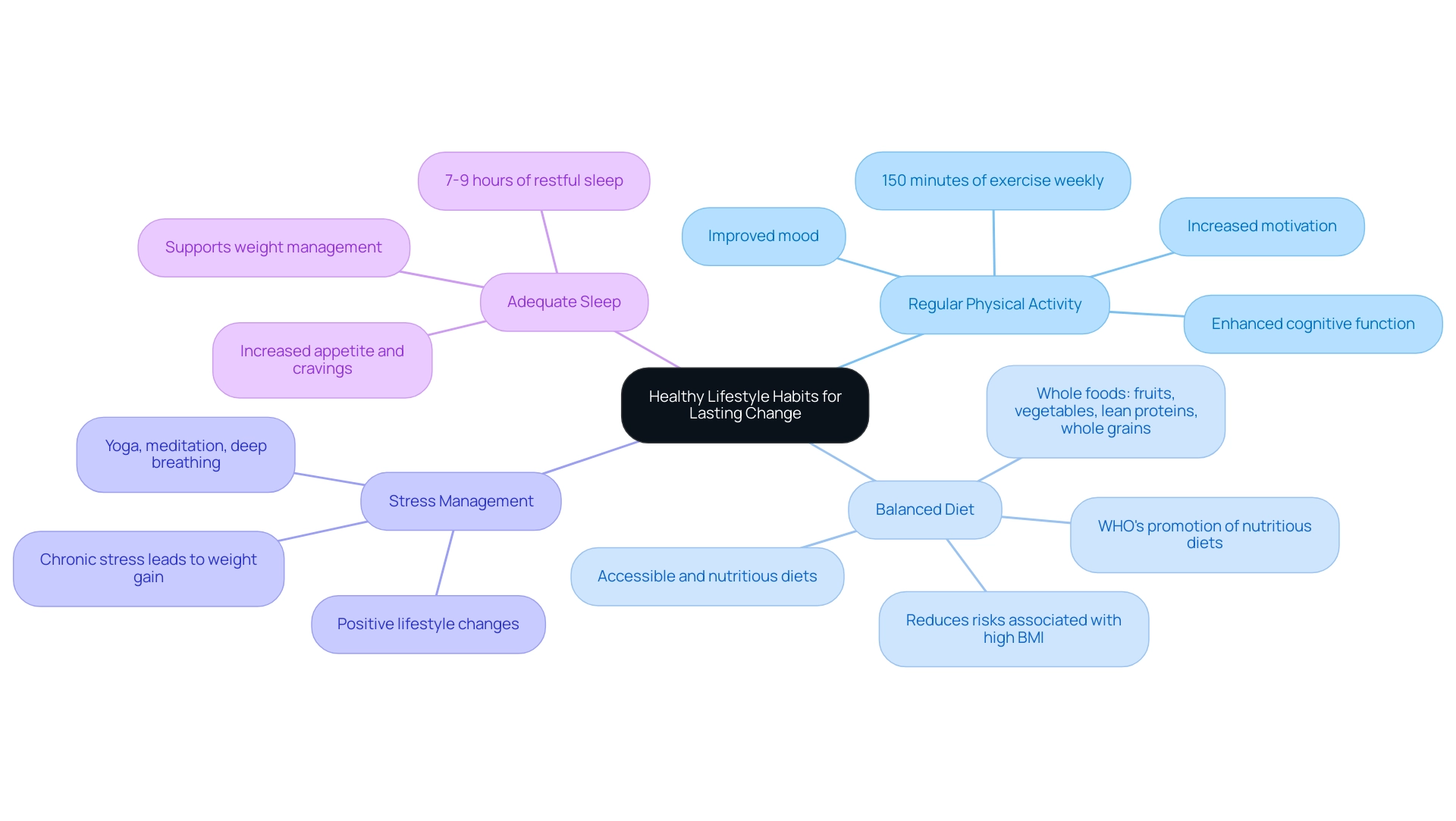
When to Consult a Professional for Personalized Guidance
If your attempts to reduce the stomach pouch are proving ineffective, or if you have specific health concerns, seeking professional guidance can be a pivotal step in your journey. Consider the following experts:
- Nutritionists: These experts offer personalized dietary advice tailored to your unique needs, helping you navigate the complexities of nutrition to achieve your weight loss goals. Research indicates that interventions involving nutrition professionals can significantly enhance dietary success rates, with over 60% of programs featuring six or more sessions yielding positive outcomes. As Kimberly A Gudzune, MD, states, "Improving the quality of weight management training for nutritional professionals could translate into better patient outcomes."
- Personal Trainers: A certified personal trainer can create a customized fitness program that aligns with your individual goals and abilities. Their expertise not only helps in designing effective workouts but also provides motivation and accountability, which are crucial for maintaining consistency. Studies show that individuals who engage with personal trainers often experience improved fitness outcomes and greater adherence to exercise regimens. At Foresight Health Coaching, our skilled coaches employ evidence-based methods to empower clients to flourish in their wellness journeys. One satisfied client shared, "Working with my personal trainer at Foresight Health Coaching transformed my approach to fitness and helped me achieve my goals."
- Medical Professionals: If you are considering surgical options or have underlying medical conditions, consulting a healthcare provider is essential. They can evaluate your overall well-being and guide you on the best course of action, ensuring that any interventions are safe and suitable for your situation.
Interacting with these experts can offer the essential support and accountability to assist you in reaching your wellness goals effectively. Furthermore, investing in employee well-being through partnerships like the Corporate Wellness Partnership with Foresight Health Coaching not only enhances team culture but also drives productivity and organizational success. Contact us today to learn how we can support your journey towards better health!
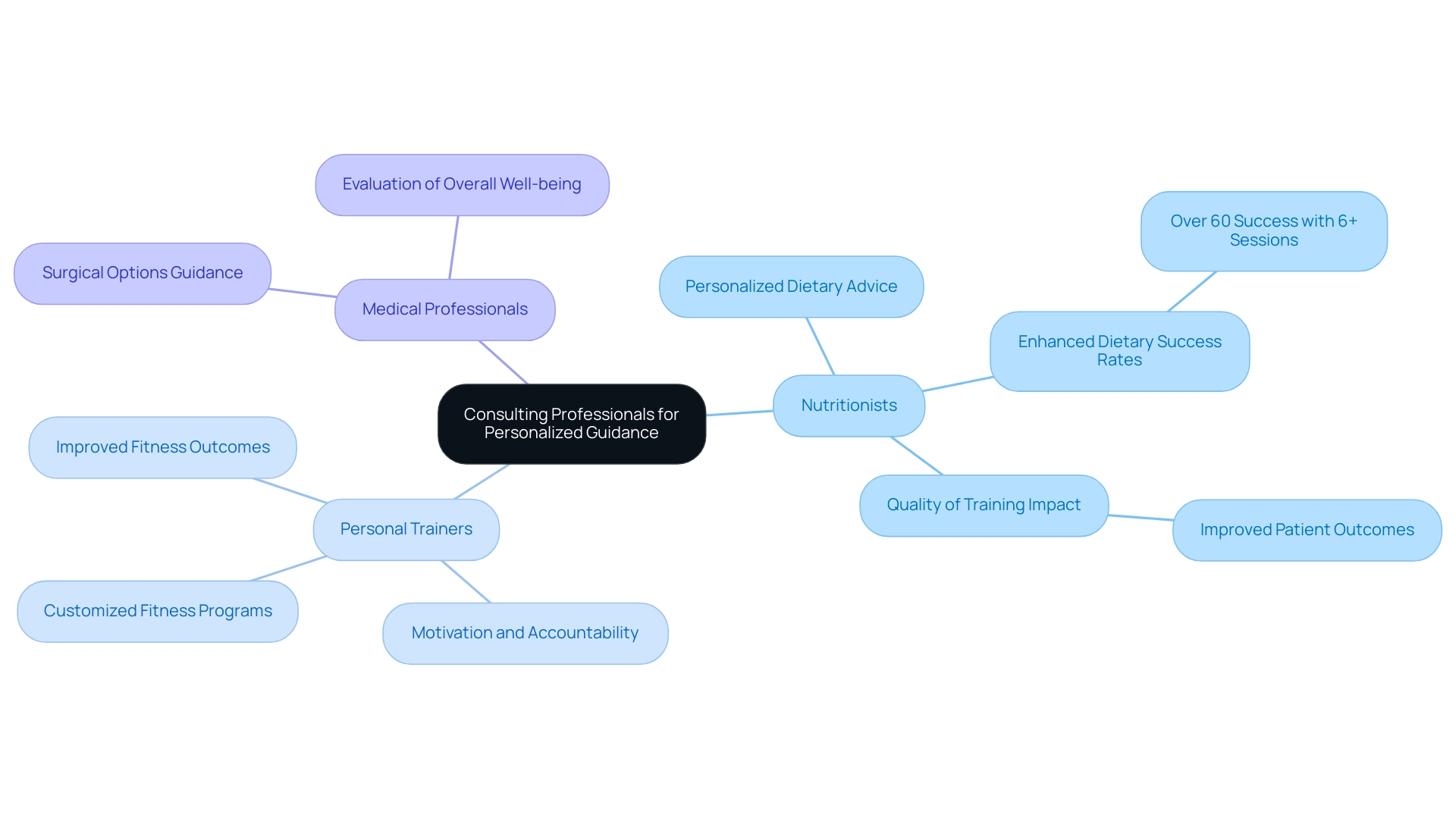
Conclusion
Addressing the issue of the stomach pouch necessitates a multifaceted approach that includes understanding its causes, exploring effective treatment options, and adopting healthy lifestyle habits. The accumulation of abdominal fat can stem from hormonal changes, genetics, pregnancy, and lifestyle choices. Recognizing these factors is the first step toward effectively tackling the concern and enhancing overall well-being.
Non-surgical treatments such as CoolSculpting and SculpSure present promising results for individuals seeking to reduce abdominal fat without invasive procedures. Furthermore, incorporating regular physical activity and targeted exercises can significantly contribute to a flatter stomach and improved overall health. Nutritional strategies, including increasing protein intake and limiting sugars, play a vital role in supporting fat loss and promoting a balanced diet.
Ultimately, achieving lasting change requires a commitment to a healthier lifestyle, encompassing stress management and adequate sleep. For those facing challenges in their journey, consulting with professionals such as nutritionists, personal trainers, and medical experts can provide tailored guidance and support. By embracing these strategies and seeking personalized help when necessary, individuals can embark on a successful path toward reducing their stomach pouch and fostering a healthier, more confident self.
Frequently Asked Questions
What is a belly pooch?
A belly pooch refers to the accumulation of fat and sometimes loose skin in the midsection, typically located below the belly button.
What factors contribute to the development of a belly pooch?
Key contributors include hormonal changes, pregnancy, genetics, and lifestyle factors such as diet and physical activity.
How do hormonal changes affect belly fat?
Hormonal fluctuations, especially during menopause, can influence fat distribution, leading to increased storage in the midsection due to altered metabolism and fat storage patterns.
What impact does pregnancy have on the stomach area?
Pregnancy can cause the stomach muscles to stretch and weaken, potentially leading to a pouch after delivery, influenced further by hormonal changes that promote fat retention in the belly area.
How does genetics influence belly fat accumulation?
Genetic factors determine body fat distribution, meaning individuals with a family history of belly fat accumulation may be more likely to develop a stomach pouch.
What lifestyle factors contribute to the development of belly fat?
Sedentary behavior, poor dietary choices, and insufficient physical activity are significant contributors to belly fat accumulation.
What strategies can help reduce abdominal fat?
Effective strategies include maintaining a healthy diet, engaging in regular physical activity, getting adequate sleep, and managing stress.
What is diastasis recti, and how does it relate to postpartum women?
Diastasis recti is a condition where the abdominal muscles separate, leading to a bulging effect. It is common among postpartum women and raises concerns about core strength and appearance.
How does loose skin after childbirth affect women?
After childbirth, skin may struggle to regain its elasticity, contributing to the pouch effect and impacting body image, often leading to dissatisfaction with post-pregnancy appearance.
What challenges do women face regarding weight retention after pregnancy?
Many women find it difficult to shed the weight gained during pregnancy, which can lead to decreased self-esteem and motivation.
How can regular physical activity benefit postpartum women?
Engaging in regular physical activity can improve motivation at work and enhance self-esteem and body image for postpartum women.
What role do personalized coaching and wellness programs play in addressing these issues?
Personalized coaching can provide tailored strategies to help women regain confidence, address body image issues, and support healthier lifestyle adjustments post-pregnancy.

